Structure of Cell – Basic Components and Cell Organelles
Structure of Cell
Table of Contents
- Besides the difference in shape, size and activities, the Structure of Cell have three basic components which are
-
- The Cell Membrane or Plasma Membrane and Cell Wall (in Plant Cells only)
- The Nucleus
- The Cytoplasm with Cytosol and Cell Organelles
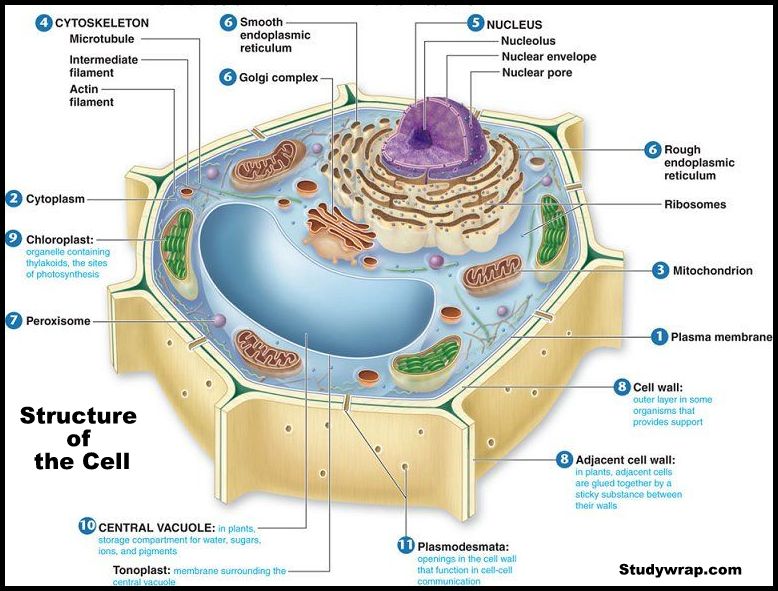
- The Outer membrane of the Cell is called Plasma Membrane.
- Inside the Plasma Membrane, lies the Cytoplasm in which various cell Organelles and Nucleus is suspended.
- All the Functions of the Cell is performed by these cell Organelles which are the part of Structure of Cell.
1. Cell Membrane
(also known as Plasma Membrane)
Main Characteristic
-
- Very thin, Delicate, elastic, flexible, living membrane
- Made up of 75% phospholipids. Also contains Proteins, cholesterol and Polysaccharides.
- Outermost in animal cells, Lies next to cell wall in plant cells and determines the Structure of Cell.
- Selectively-permeable.
- In 1972, Singer and Nicolson suggested Fluid Mosaic Model which explain the ultrastructure of Plasma membrane.
Chief Functions
-
- Separate the contents of cell from its surroundings
- Regulates the entry of certain solutes and ions
- Maintains shape of the cell( in animal cells only)
- Performs physical activities such as diffusion, Osmosis, Active Transport etc.

Structure of Plasma Membrane
-
- Composed of Phospholipids (75%), Also contains Proteins, Cholesterol and Polysaccharides.
- Fluid Mosaic Model – proposed by Singer and Nicolson in 1972.
- According to this model, membrane contain bi-molecular lipid layers, surface of which is interrupted by proteins.
- Two types of proteins are present in lipid layers namely – Intrinsic Proteins and Extrinsic Proteins.
- Intrinsic Proteins – completely covered by Lipid bi-layer
- Extrinsic Proteins – Occurs on outer or inner surface of the lipid membrane
- Proteins serves as –
-
- Enzymes – catalyse chemical reactions within the membrane
- Transport proteins or Permeases – for movement of water soluble ions
- Pumps – active transport
- Receptor Proteins – for endocytosis
-
1a. Cell Wall (Plant cells only)
Main Characteristic
-
- Outermost in plant cells which determine the rigid Structure of Cell in plants.
- Non living rigid layer surrounding the plasma membrane
- Freely permeable
- Mainly composed of fibrous polysaccharides called cellulose
Chief Functions
-
- Gives rigidity and shape to the plant cells
- Allows substances In solution to enter and leave the cell without any hindrance
- Provides protection
- Provides Mechanical Strength
Difference Between Cell Wall & Plasma Membrane
|
Cell Wall |
Plasma Membrane |
|
Occurs in Plant cells |
Found both in Plant and animal cells. |
|
Lies outside of Cells. |
Lies outside of animal cells and inner to cell wall in plant cell. |
|
Non-living and thick in plants. |
Living and thin. |
|
Rigid |
Flexible |
|
Permeable |
Selectively-Permeable |
|
Formed of Cellulose, Pectin and Hemicellulose. |
Formed of Lipids and Proteins |
|
Major Function – Protection and Mechanical Strength |
Major Functions – to hold cellular content and control |
2. Nucleus
Nature and Occurrence
-
- Nucleus is the main component of Structure of Cell.
- Large centrally placed spherical cellular component.
- It contains the following components –
- Nuclear Membrane also known as Nuclear Envelope
- Nucleoplasm
- Nucleopores or Nuclear pores
- Nucleolus
- Genetic Material or Chromatin Fibres
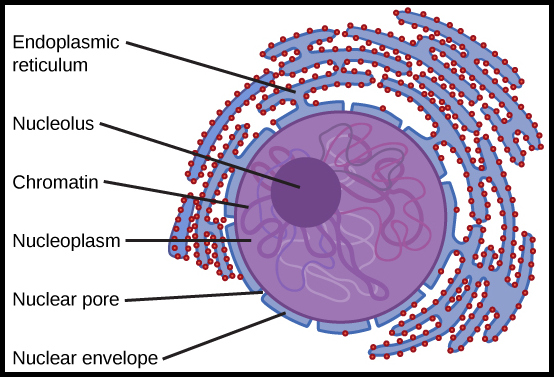
Chief Characteristics
-
- Bounded by two nuclear membrane, forming Nuclear Envelope.
- Nuclear Envelope separates the Nucleus from Cytoplasm.
- Inside the Nuclear envelope a liquid is filled which is known as Nucleoplasm.
- Nuclear envelope contains many pores called Nuclear Pores which allows the transfer of materials between nucleoplasm and cytoplasm.
- Nucleolus are non-membranous body rich in Protein and RNA and acts as the site for Ribosome formation.
- Chromatin Material are thin, thread like structure which are composed of DNA and Proteins. Chromatin fibres forms the Chromosomes during the time of cell Division.
Functions
-
- Controls all metabolic Activities of the cell.
- Regulates Cell Cycle.
- Concerned with the transmission of Hereditary traits from Parents to Offsprings.
3. Cytoplasm
Main Characteristic
-
- Occurrence – between plasma membrane and nuclear envelope
- All the organelles together with aqueous ground substance, cytosol inside the plasma membrane excluding nucleus is called Cytoplasm.
- Contains a mixture of water and soluble inorganic and organic compounds, and various organelles.
- Cytosol is about 90% water and forms solution which contains all biochemical of life.
Parts of Cytoplasm
-
-
Cytosol
-
-
-
- Cytosol is about 90% water and forms solution which contains all biochemical of life.
- Soluble part of cytoplasm
-
Functions
-
-
- acts as a vital chemicals such as amino acids, vitamins, ions etc.
- Site of certain metabolic pathways eg. Glycolysis. Synthesis of various compounds etc.
-
-
-
Cell Organelles
- Cell performs its various functions with the help of various organelles such as – mitochondria, ribosomes, endoplasmic reticulum, plastids etc.
-
Functions
-
-
- Synthesis of various substances
- Secretion of cell products
- Digestion
- Generation of energy etc.
-
Chief Functions
-
- Different organelles contained in it performs different functions.
- All metabolic activities occur in it.
- Medium for initial steps of respiration (production of pyruvic acid) (anaerobic respiration).
Cell Organelles
Occurrence and Nature
-
- Cell Organelles are the Various organs of the cell which performs various functions of the cell.
- These Cell Organelles are responsible for the synthesis, secretion, digestion, respiration and various other processes of the cell.
Types of Cell Organelles
-
-
- Endoplasmic Reticulum
- Ribosomes
- Golgi Apparatus
- Lysosomes
- Mitochondria
- Plastids
- Vacuoles
- Peroxisomes
- Centrosomes etc.
-
A. Endoplasmic reticulum (ER)
Main Characteristic
-
-
- Irregular membranous network of double membraned tubules.
- continuous with plasma membrane on the outside & nuclear membrane on the inside.
- It is of two types –
- Smooth ER(without ribosomes)
- Rough ER (with ribosomes)
-
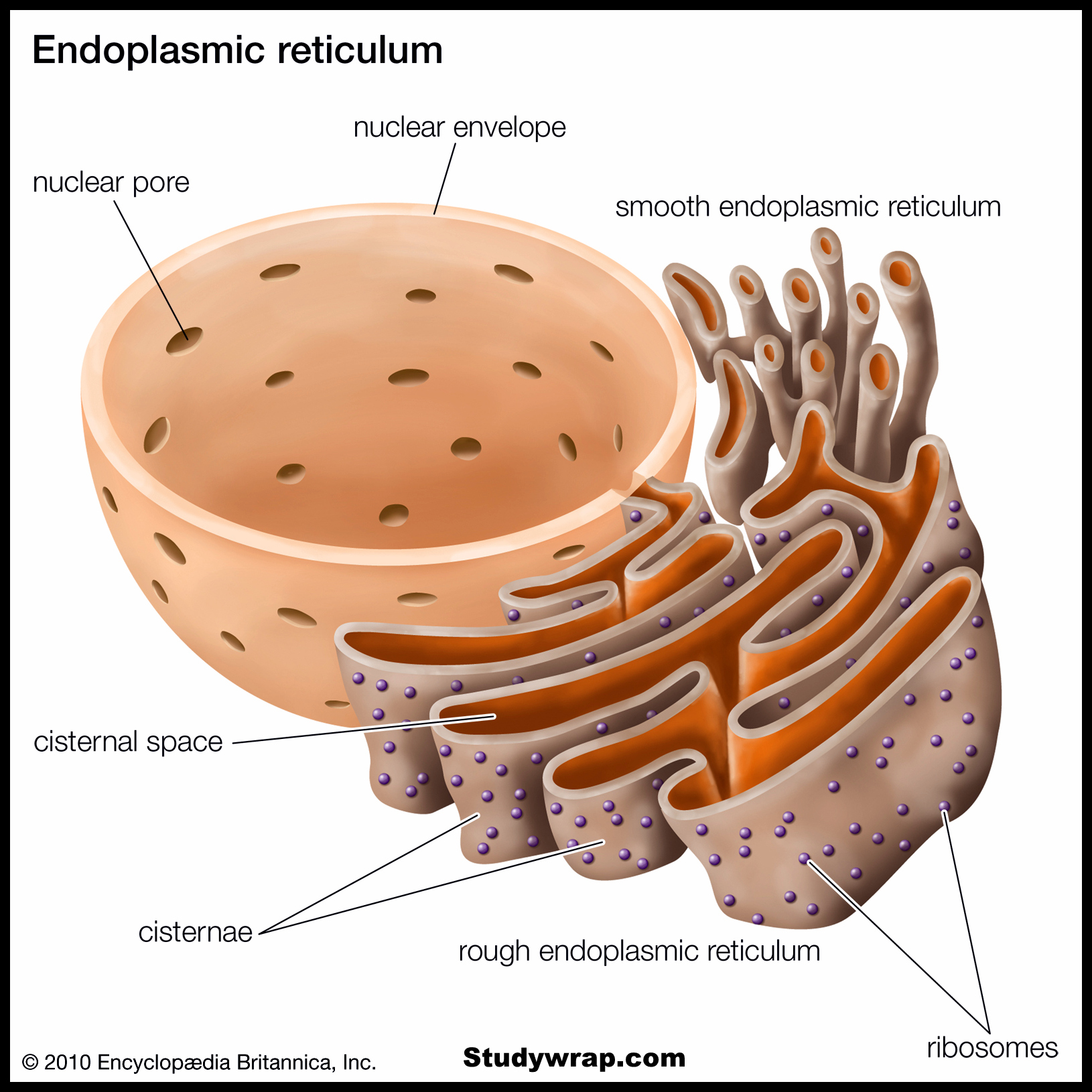
Difference Between Smooth Endoplasmic Reticulum and Rough Endoplasmic Reticulum
|
Rough Endoplasmic Reticulum |
Smooth Endoplasmic Reticulum |
|
Contains flattened sacs called Cisternae. |
Mainly formed of Vesicles and tubules. |
|
Ribosomes attached to outer surfaces. |
Do not contains Ribosomes. |
|
Specialised in Protein Synthesis. |
Specialised in Lipid and Steroids synthesis. |
|
Found in abundance in Exocrine pancreatic cells and plasma cells. |
Abundant in liver and testicular cells. |
Chief Functions
-
-
- Supportive skeletal framework for cell.
- Synthesis and transport of proteins & fats.
-
Some Special Functions –
-
-
- Helps in detoxification – metabolizes various toxins which enters through food, air or water.
- SER helps in synthesis of glycolipids, phospholipids and cholesterol.
- RER helps in synthesis of various secretory proteins such as mucus, Digestive enzymes and hormones.
- SER helps in synthesis of Steroid hormones such as estrogens, testosterone and cortisol.
- Helps in formation of Plasma membrane.
-
B. Ribosomes
Main Characteristic
-
-
- Small, dense, spherical granules.
- Either scattered in cytoplasm or attached to the outside of Endoplasmic Reticulum.
- Mainly composed of RNA and Proteins.
- Absent in Mammalian RBC.
-
Chief Functions
-
-
- Protein Synthesis
-
C. Golgi Apparatus (in animal cells)
(called Dictyosomes in plant cells)
Main Characteristic
-
-
- Consists of set of membrane bounded Fluid filled vesicles, vacuoles and flattened cisternae.
- Cisternae are formed at cis face of Golgi.
- Vesicles are formed at trans face of Golgi.
- It arises from Smooth ER.
- Absent in Bacteria, Blue-green algae, mature sperms and RBC of mammals and other animals.
-
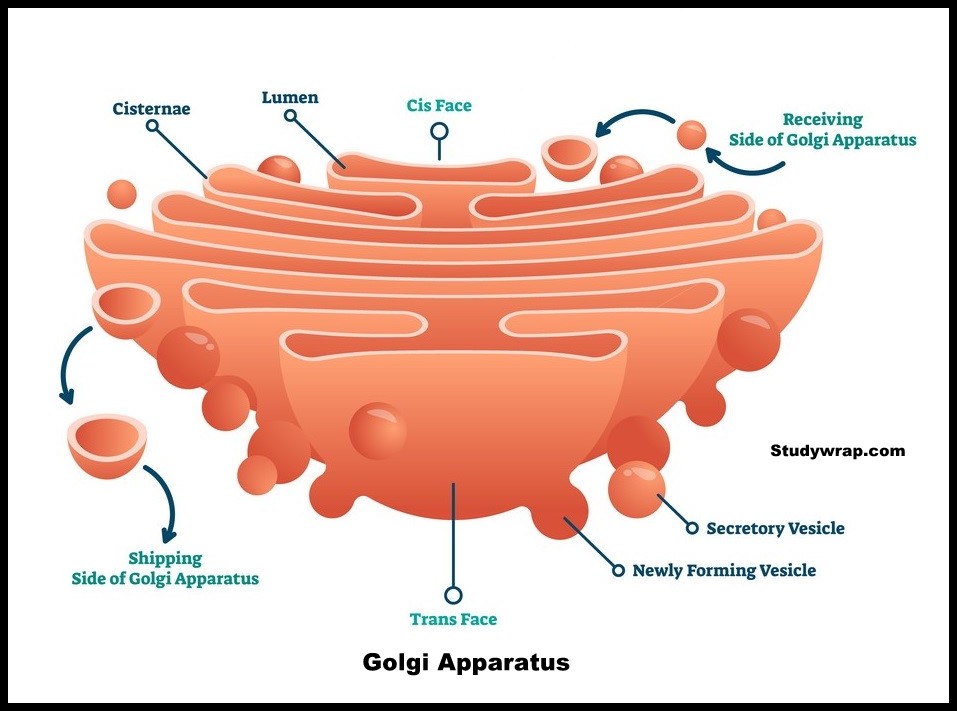
Chief Functions
-
-
- Acts as a assembly area for storage, processing and packaging of various cellular secretions.
- Synthesis and secretion of enzymes and hormones etc.
- Involved in synthesis of Cell wall, Plasma Membrane and Lysosomes.
- Formation of acrosome of sperm.
-
D. Lysosomes
Main Characteristic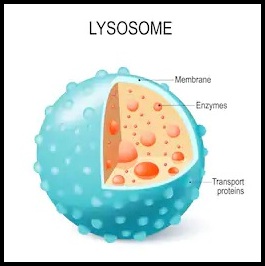
-
-
- Membranous sacs budded off from Golgi bodies.
- Small single membrane vesicles
- Contains 40 different types of powerful enzymes.
-
Chief Functions
-
-
- Intracellular digestion
- Destroy foreign material or body eg. Bacteria.
- Helps in removal of poorly working cell organelles so replacement can be done. Hence, called scavengers and cellular housekeepers.
- When cell is old or injured, these rapidly destroy cell organelles, hence called as “SUICIDE BAGS”.
- Digest cartilages during formation of Bones.
-
E. Mitochondria
Main Characteristic
-
-
- Tiny bodies of various shapes but usually sausage like.
- Double walled, inner walls thrown into folds(cristae).
- Cristae are studded by F1 Particles or Oxysomes.
- Have their own DNA (containing several genes).
- Also contain their own ribosomes.
- Filled with a Proteinaceous matrix
- Absent in Bacteria and RBCs of Mammals.
-

Chief Functions
-
-
- Synthesis of respiratory enzymes.
- Site of Cellular respiration
- Release of energy from pyruvic acid produced in cytoplasm in the form of ATP.
- Hence called Power House of the Cell.
- This ATP is used for synthesis of Chemical Compounds and for mechanical work.
-
F. Plastids (only in Plant cell)
Main Characteristic
-
-
- Double Membraned, Proteinaceous matrix, contains own DNA and Ribosomes.
- Self replicating organelles.
-
Types of Plastids
-
-
- Plastids are of following types –
- Chromoplast – Coloured Plastids
- Chloroplast – Green coloured Plastids
- Leucoplast – Colourless Plastids
-
Chief Functions
-
-
- Chloroplasts (green) trap solar energy for photosynthesis by the help of pigment called chlorophyll.
- Leucoplast – Store Starch.
- Chromoplast – impart color to flowers and fruits, contain the pigments Xanthophyll (yellow coloured pigment) carotene (Orange-red pigment)
-
G. Chloroplast
Main Characteristic
-
-
- Disc-like structure called thylakoids contains chlorophyll.
- Chlorophyll helps in Photosynthesis.
- Double membrane structure.
- Has two distinct regions –
- Grana – stacks of membrane bounded discs called thylakoids which contains chlorophyll.
- Stroma – homogeneous matrix. Contains photosynthetic enzymes, starch grains, DNA and Ribosomes.
-
Chief Functions
-
-
- Trap Solar energy and use it to produce food.
- Hence, called Kitchen of the Cell.
-
Difference between Leucoplast and Chromoplast
|
Leucoplast |
Chromoplast |
|
Colourless |
Range from brownish to reddish in color |
|
Cylindrical or rounded in shape |
Irregular in shape |
|
Found in unexposed cells or where light is not available |
Found in both exposed or unexposed cells |
|
Can change to other type of plastids |
Do not changes to other types of plastids. |
|
Takes part in storage of Food Eg. Amyloplast form carbohydrates, elaioplast for lipids |
Provides colour to organs to attract pollinators and |
|
Found in Parenchymatous cells, embryonic cells, sex cells and meristematic cells. |
Difference between Chloroplast and Chromoplast
|
Chloroplast |
Chromoplast |
|
Green Plastids |
Non-green coloured plastids. |
|
Contains chlorophyll and carotenoids |
Chlorophyll absent Carotenoids |
|
Lamella are present |
Lamella are absent |
|
It is site for Photosynthesis |
They add color to the organ are attracting animals for |
|
Found in Mesophyll cells of leaf and Chlorenchyma cells in stem |
|
Difference between Chloroplast and Mitochondria
|
Mitochondria |
Chloroplast |
|
Occurs in cells of aerobic organisms (exception- RBCs of Mammals) |
Occurs in the cells of green photosynthetic parts of |
|
Colourless |
green in colour |
|
Shape is rod like or sausage like. |
Generally disc like in outline |
|
Inner membrane thrown into folds called Cristae. |
Inner membranes forms flattened sacs called thylakoids or lamellae. |
|
Liberate energy |
Traps solar energy and convert it into chemical energy. |
|
Performs oxidation of food |
Synthesise food by photosynthesis |
|
Consume Oxygen and liberate Carbon dioxide |
Consume Carbon dioxide and liberate oxygen |
H. Vacuoles
Main Characteristic
-
-
- Clear spaces filled with water or other substances.
- Covered by covering known as Tonoplast.
- Animal cell has small and temporary vacuoles which stores water, glycogen and proteins.
- Plant cell has large, distinct and permanent vacuoles.
- Vacuoles are filled with Cell sap, a watery solution rich in sugar, proteins, minerals, amino acids etc. in plants cell.
-
Chief Functions
-
-
- Act as a Storage Sacs by Storage of Water and other Substances Such as food, Waste Materials etc.
- Give Turgidity and rigidity to Plant cells.
- Contains pigments like anthrocyanins etc.
- Maintains osmotic pressure of the cell
- Stores toxic metabolic by-products of plant cell.
-
I. Centrosomes
Main Characteristic
-
-
- Found only in Animal Cells.
- Not bounded by any membrane.
- Region surrounding the centrioles, located near nucleus.
- Consists of one or two pair of centrioles.
- Centrioles are hollow and cylindrical structure made up of Microtubules.
- Plant cells have Polar Caps in place of Centrioles.
-
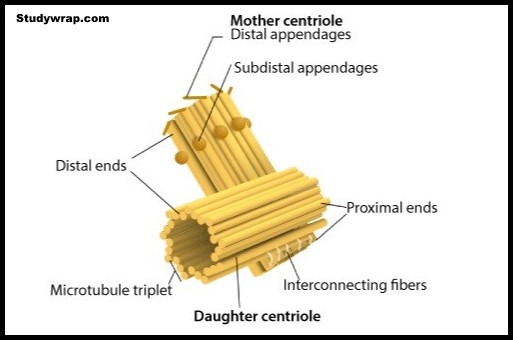
Chief Functions
-
-
- Initiates and regulates cell division
- Forms Spindle Fibers with help of asters.
-
J. Peroxisomes
Main Characteristic
-
-
- Small spherical organelles containing powerful oxidative enzymes.
- Bounded by single membrane.
- Found in Kidney and Liver Cell.
- Contains crystallized proteins called Catalase Enzyme.
-
Chief Functions
-
-
- Specialised for carrying oxidative reactions such as detoxification.
-
K. Flagellum and Cilium
Main Characteristic
-
-
- It is a whip like structure present outside the cell.
- It is a tiny projections which arises from the cytoplasm and extends to outside by a pore in cell membrane or cell wall.
-
Chief Functions
-
-
- Helps in the movement of the cell.
- Eg. Sperm
-
So, this was all about the Structure of Cell – Basic Components and Cell Organelles.
In the Next Post (Click Here), we will discuss about the Cell Cycle and Cell Division : Types of Division (Interphase).

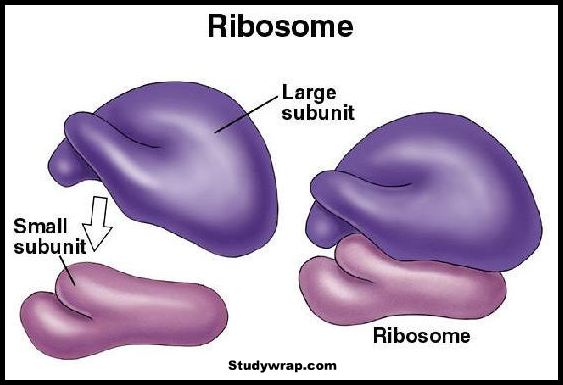
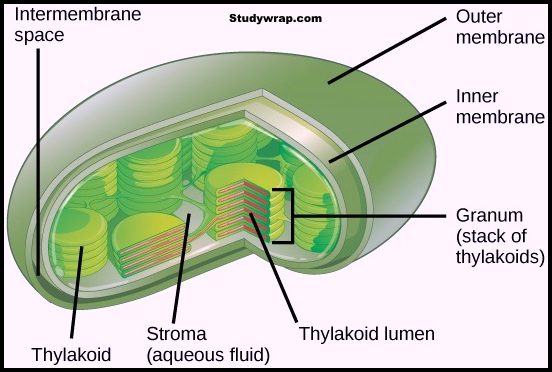

Very crisp notes… Helped me a lot in making my project thanks